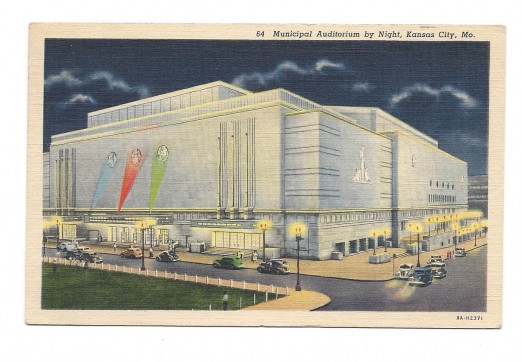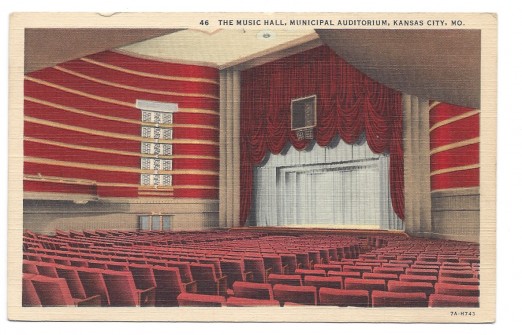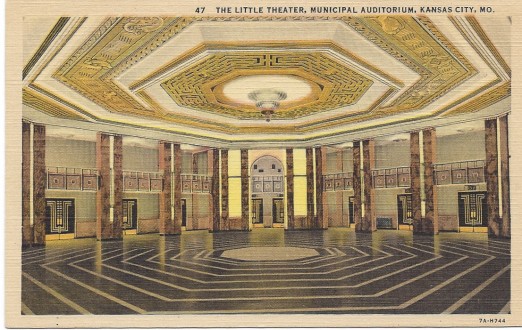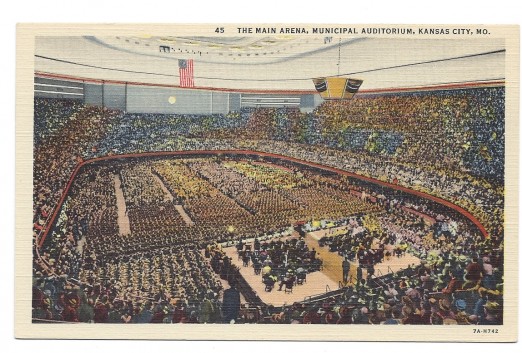Gimme that Kansas City Spirit!
Convention center, entertainment venue, Grand Ballroom
While surrounding skyscrapers dwarf the concrete fortress on 13th Street in downtown Kansas City, Mo, viewed head on, the Municipal Auditorium is as magisterial today as it was in 1899 and again when rebuilt in 1935. That year, Architectural Record named the auditorium “one of the 10 best buildings in the world.” This century, the Princeton Architectural Press included it in their list of 500 notable buildings in America.
To the passerby, its sheer size and Art Deco detail command attention. And while sleek new arts spaces are on the rise throughout the metro, something about Municipal Auditorium remains uniquely supreme.
In function alone, Municipal Auditorium deserves this distinction. The gargantuan center comprises three spaces: the multipurpose arena—home of sports, circuses, and presidential speeches; the Music Hall for performing arts; and the Little Theatre, a reception room and banquet hall. Over the years its spaces have served Broadway shows like The Lion King, basketball tournaments with the NCAA, and visits from the likes of President Franklin D. Roosevelt. He made the original dedication, before a packed crowd in the arena, in October 1936.
FDR was a symbolically appropriate choice to dedicate the Municipal Auditorium. Its construction was a marker for the sort of turn-around in Kansas City that he was trying to kick start across America. While much of the country was left reeling during the Great Depression, Kansas City not only survived the 1930s, but came out stronger, thanks in large part to its own kind of New Deal—the Ten Year Plan.
In order to bolster Kansas City infrastructure and provide jobs to the unemployed, the Ten Year Plan began even before Roosevelt came to office, masterminded in 1931 by Boss Tom Pendergast, city manager H.F. McElroy, and Chamber of Commerce president Conrad Mann. From improving sewers to paving Brush Creek, the Ten Year Plan proved an effective and impressive way to help Kansas City workers help Kansas City.
Notable buildings constructed during this period included similarly styled City Hall, Jackson County Courthouse, and Municipal Auditorium. The aesthetic similarity shared by these buildings can be traced to the influence of Tom Pendergast in the Ten Year Plan: using his political influence to gain support from the WPA, his Ready-Mix Concrete Company became the primary supplier of material for the building projects in the early-1930s.
It was a remarkable display of cooperation and vision, exuding the exact gumption that 30 years earlier had earned the reputation of “Kansas City spirit.” In the late 1800s, the original Convention Hall on 13th and Central Streets was envisioned to be a center worthy of national prestige. To raise funds, a concert was held where Kansas Citians made donations ranging from donkeys, pigs and Herefords to pianos. Built in 1899, the first Convention Hall was finished in time to hold that year’s Democratic National Convention. A tragic fire struck the building just three months before the event, forcing investors and the community to pull together a widespread effort to rebuild the devastated hall. The project was completed in a miraculous 90 days, allowing for the show to go on as planned, and propagating a public embrace of a newfound “Kansas City spirit.” This second Convention Hall stood for 36 years until demolition began on July 6, 1936. Workers unearthed a “century box,” which was laid under the original cornerstone in 1899. The box contained several photos of Kansas City citizens and a newspaper from the exact date the cornerstone was laid. The Barney Allis Plaza stands today where the second Convention Hall built.
It makes sense that in this century the Municipal Auditorium has become part of the Kansas City Convention and Entertainment Facilities, creating a massive multi-block collection of buildings meant to impress visitors and residents.
The Convention Center’s New Grand Ballroom sits just south of Municipal Auditorium, a dazzling display of glass facing the Kauffman Center for the Performing Arts. One could easily mistake the New Grand Ballroom for an extension of the Kauffman. The proximity says a lot about this new era of boom in Kansas City. Municipal Auditorium may no longer be the choice venue for throngs of crowds like it hosted when Elvis visited in 1956, but the last decade has brought a rush of new buildings and added spaces for concerts, performances, and sports.
In 2008, a future president visited Kansas City. And just as Franklin D. Roosevelt and Harry Truman and Gerald Ford and Ronald Reagan had done before, Barack Obama spoke to an overflowing crowd at Municipal Auditorium. In a growing city, through changing times, the concrete behemoth on 13th Street has held fast to its tradition as a place that can bring Kansas Citians together.














